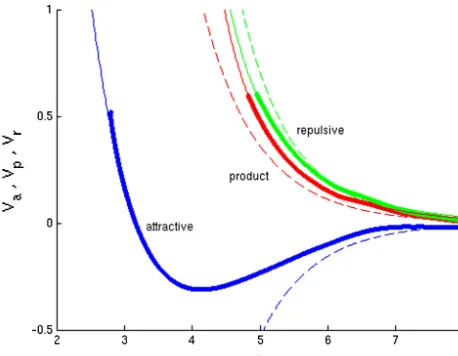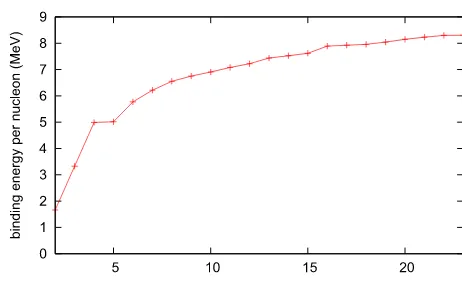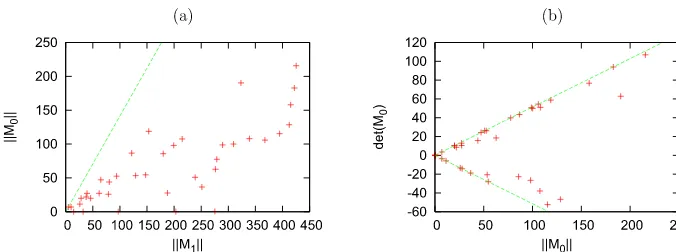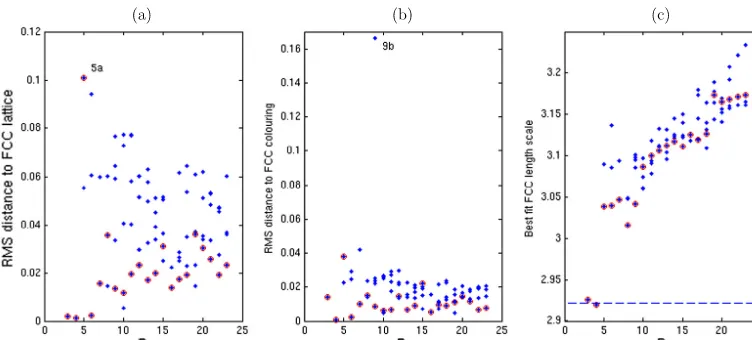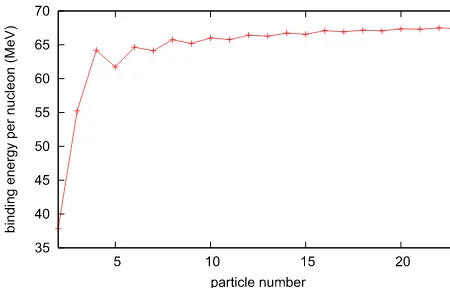ScienceDirect
Nuclear Physics B 917 (2017) 286–316
www.elsevier.com/locate/nuclphysb
A
point
particle
model
of
lightly
bound
skyrmions
Mike Gillard
b,
Derek Harland
a,
Elliot Kirk
c,
Ben Maybee
a,
Martin Speight
a,∗aSchoolofMathematics,UniversityofLeeds,LeedsLS29JT,UK
bTheWolfsonSchoolofEngineering,UniversityofLoughborough,LoughboroughLE113TU,UK cDepartmentofMathematicalSciences,UniversityofDurham,DurhamDH13LE,UK
Received 6January2017;accepted 31January2017 Availableonline 16February2017
Editor: StephanStieberger
Abstract
A simple model of the dynamics of lightly bound skyrmions is developed in which skyrmions are replaced by point particles, each carrying an internal orientation. The model accounts well for the static energy minimizers of baryon number 1 ≤B≤8 obtained by numerical simulation of the full field theory. For 9 ≤B≤23, a large number of static solutions of the point particle model are found, all closely resembling size Bsubsets of a face centred cubic lattice, with the particle orientations dictated by a simple colouring rule. Rigid body quantization of these solutions is performed, and the spin and isospin of the corresponding ground states extracted. As part of the quantization scheme, an algorithm to compute the symmetry group of an oriented point cloud, and to determine its corresponding Finkelstein–Rubinstein constraints, is devised. ©2017 The Author(s). Published by Elsevier B.V. This is an open access article under the CC BY license (http://creativecommons.org/licenses/by/4.0/). Funded by SCOAP3.
1. Introduction
The Skyrme model isan effective theory of nuclearphysicsinwhich nucleonsemergeas topologicalsolitonsinafieldwhosesmall amplitudetravellingwavesrepresentpions. Itthus providesaunifiedtreatmentofbothnucleonsandthemesonswhich,intheYukawapicture,are responsibleforthestrongnuclearforcesbetweenthem.WhiletheSkyrmemodelhasbeen su-percededasafundamentalmodelof stronginteractionsbyQCD,interestinthemodelrevived
* Correspondingauthor.
E-mailaddress:speight@maths.leeds.ac.uk(M. Speight). http://dx.doi.org/10.1016/j.nuclphysb.2017.01.027
onceitwasrecognizedtobeapossiblelowenergyreduction ofQCDinthelimitoflargeNc
(numberofcolours)[17,16],andmuchworkhasbeenconductedtoextractphenomenological predictionsaboutnucleifromstandardversionsofthemodel[11,12,10,3].Manyofthese predic-tionsareingoodqualitativeagreementwithexperiment,andrecentimprovementsinskyrmion quantizationschemesofferhopeofsignificantfurtherimprovementtocome[6,7].
Oneareainwhichstandardversionsofthemodelperformpoorly,however,isthatofnuclear bindingenergies:typically,classicalskyrmionsaremuchmoretightlyboundthanthenucleithey aremeanttorepresent(byafactorof15orso).Inrecentyears,nofewerthanthreevariantsof themodelhavebeenproposedwhichseektoremedythisproblem.Ineachcase,themodelis, bydesign,asmallperturbationofaSkyrmemodelinwhichthebindingenergiesvanishexactly. Perhapsthe mostradicalproposal, duetoSutcliffeandmotivatedby holography,couplesthe Skyrmefieldtoaninfinitetowerofvectormesons[15].Smallbutnonvanishingbindingenergies are(conjecturally)introducedbytruncatingthisinfinitetoweratsomehighbutfinitelevel.This proposal,whileelegant,hassofarnotbeenamenabletodetailed analysis.Asecondproposal, duetoAdam,Sánchez-GuillénandWereszczy´nski,startswithamodelwhichisinvariantunder volumepreservingdiffeomorphismsofspace,thenperturbsitbymixingwithasmallfractionof theconventionalSkyrmeenergy[1].Skyrmionsinthismodelhavetheattractivefeatureofbeing somewhatakintoliquiddrops.However,thelarge(infact,infinitedimensional)symmetrygroup oftheunperturbedmodelisextremelyproblematicfornumericalsimulations,andtheshapesand symmetriesof classicalskyrmions,evenforratherlowbaryonnumber(B≥3)are,sofar,not knowninthismodelintheregimeofrealisticallysmallbindingenergy[5].
Inthispaperwewillstudythethird(andarguablyleastradical)proposal,originallyduetoone ofus[8].ThisamountstomakinganonstandardchoiceofpotentialterminthestandardSkyrme lagrangianand,moreimportantly,radicallyshiftingtheweightingofthederivativetermsfrom thequadratictothequartic.Theresultingmodelisstillamenabletonumericalsimulation,but itsclassicalsolutionsarequitedifferentfromconventionalskyrmions:thelowestenergySkyrme fieldofbaryonnumberBnowresemblesalooselyboundcollectionofBsphericallysymmetric unit skyrmions, ratherthan a tightly bound objectin whichthe skyrmions have mergedand losttheirindividualidentities.Intheterminologyof[14],whichstudieda(2+1)-dimensional analogueofthemodel,skyrmionsinthislightlyboundSkyrmemodelprefertoholdthemselves alooffromoneanother.Numericalanalysisreveals[5]thattheyalsoprefertoarrangethemselves ontheverticesofafacecentredcubicspatiallattice,withinternalorientationsdictatedbytheir latticeposition.Thissuggeststhat,unlikeconventionalskyrmions,lightlyboundskyrmionscan bemodelledaspointparticles,eachcarryinganinternalorientation,interactingwithoneanother throughsomepairwiseinteractionpotentialwhoseminimumencouragesthemtositatafixed separation withtheir internal orientationscorrelated.The aim of thispaper is toderive such asimplepoint particlemodel, compare itspredictions with numericalsimulationsof the full fieldtheory, anduse it to extract, via rigid body quantization,phenomenological predictions aboutnucleiwithbaryonnumber2≤B≤23.Asimilarprogramme(minusquantization)forthe (2+1)-dimensional analoguemodelwascompletedin[14].
determinedbyadhocmeans:onelooksatsuitablepicturesoftheskyrmion,predictsasymmetry byeye,thenchecksitbyoperatingonthenumericaldata.Bycontrast,we willdevelopan al-gorithmwhichautomaticallycomputesthesymmetrygroupofanypointparticleconfiguration. Thisallowsustocompletelyautomatetherigidbodyquantizationscheme.Theresultis,asa phenomenologicalmodel ofnuclei, moderatelysuccessful:rigid bodygroundstates plausibly accountforthelightestnucleusofbaryonnumberBfor12ofthe23valuesconsidered. Presum-ablythiscanbeimprovedbyreplacingrigidbodyquantizationbysomethingmoresophisticated. Therestofthepaperisstructuredasfollows.Insection2wereviewthelightlyboundSkyrme model, focusing onits spin–isospinsymmetryandassociated inertia tensors. Insection 3 we introducethepointparticlemodel,theninsection4wedescribeanumericalschemetofindits energy minimizers,andpresentthe resultsof thisscheme.Insection5 weformulatetherigid bodyquantizationofourclassicalenergyminimizers,focusing particularlyontheFinkelstein– Rubinsteinconstraints.Someconcludingremarksandpossiblefuturedirectionsofdevelopment arepresentedinsection6.
2. The lightly bound Skyrme model
Thefieldtheoryofinterestisdefinedasfollows.ThereisasingleSkyrmefieldU:R3,1→ SU(2),requiredtosatisfytheboundaryconditionU (t,x)=1 as|x|→ ∞forallt.Suchafield, ifsmooth,hasateacht,awell-definedintegervaluedtopologicalcharge
B= − 1
24π2
R3
ij kTr(RiRjRk)d3x, (2.1)
thetopologicaldegreeofthemapU (t,·):R3∪ {∞}→SU(2)∼=S3.Sincethefieldissmooth, B(t ) issmoothandintegervalued, henceautomaticallyconserved.Physically itisinterpreted as the baryonnumberof the field U. The rightinvariant current associated withU isRμ= (∂μU )U†,intermsofwhichthelagrangiandensityis
L= Fπ2
16h¯Tr(RμR
μ)+ ¯h
32e2Tr([Rμ, Rν],[R
μ, Rν])
−Fπ2m2π
8h¯3 Tr(1−U )−
Fπ4e2α 32(1−α)2(
1
2Tr(1−U )) 4.
(2.2)
HereFπ isthepiondecayconstant,mπ thepionmass,ande >0,0≤α <1 aredimensionless
parameters.In[5]thefollowingvalueswerechosenfortheseparameterssothatclassicalbinding energiesinthemodelarecomparablewithexperimentally-measurednuclearbindingenergies1:
Fπ=36.1 MeV, mπ=303 MeV, e=3.76, α=0.95. (2.3)
Thereiscertainlyroomforimprovementinthiscalibration:forexample,obtainingthecorrect pionmasswasnotapriorityin[5],andweexpectthatamorethoroughanalysiscouldresultina parametersetforwhichmπ isclosertoitsexperimentalvalueof137 MeV.However,theaimin
thepresentpaperisnottofine-tunetheparameters,butrathertostudyqualitativepropertiesof staticsolutions,whichweexpecttobeinsensitivetodetailsofthecalibration.
1 Thevaluefor F
ItwillbeconvenienttouseFπ/4e
√
1−αasaunitofenergyand2√1−α/Fπeasaunitof
length;intheseunitsthelagrangiantakestheformL=T −V,where
T =
R3
−1
2(1−α)Tr(R0R0)− 1
8Tr([R0, Ri][R0, Ri])
d3x, (2.4)
V =
R3
(1−α)
−1
2Tr(RiRi)+m 2
Tr(1−U )
− 1
16Tr([Ri, Rj][Ri, Rj])+α( 1
2Tr(1−U ))
4d3x, (2.5)
andm:=(2mπ
√
1−α/Fπe).Intheparametersetgivenabove,m=1.00.Notethatwhenα=0, ListhelagrangianoftheconventionalSkyrmemodelwithpionmass,whileforα=1 thisisa completelyunboundmodel[8]:thereisatopologicalenergyboundoftheformV ≥const|B|, butthisisattainedonlywhen|B|≤1.
ThefirstapproximationtoanucleuscontainingBnucleonsisastaticSkyrmefieldU:R3→ SU(2)of degreeB whichminimizes the potential energy V.Thusit is importanttoidentify staticclassicalenergyminimizers.Thesearereferredtoasskyrmions.Abetterapproximationto anucleusisobtainedbyallowingsolitonstocarryspinandisospin.Thelagrangianisinvariant underaleftactionofthegroupG:=SU(2)I×SU(2)J,definedby
[(g, h)·U](t,x):=gU (t, h−1xh)g−1 (2.6)
wherewehaveidentifiedphysicalspaceR3withtheLiealgebrasu(2)via x ∼=ixjσj,σ1,σ2,σ3 beingthePaulimatrices,todefinetheactionofhon x.Equivalently,
[(g, h)·U](t,x):=gU (t, R(h)−1x)g−1 (2.7)
whereR(h)istheSO(3)matrixwithentries
R(h)ij=
1 2Tr(hσih
−1σ
j). (2.8)
The conserved quantities associated withthese symmetriesare isospin and spin.Werefer to transformationsg∈SU(2)I asisorotations,inanalogywithrotationsh∈SU(2)J.
Everyω∈g:=su(2)I⊕su(2)J definesaone-parametersubgroup{exp(tω) : t∈R}of G
isomorphictoS1,whoseactiononastaticskyrmionUgeneratesarigidlyisorotatingand rotat-ingskyrmion,Uω=exp(tω)·U,ofconstantkineticenergyT[Uω].Themappingω→T[Uω]is
aquadraticformong,andhencedefinesauniquesymmetricbilinearform :g×g→Rcalled the inertia tensoroftheskyrmionU.Byitsdefinition, vanishesonthesubspaceofgtangent totheisotropygroupGU ofU(thatis,thesubgroupGU := {(g,h)∈G : (g,h)·U=U}< G whichleavesU unchanged).IfGU isdiscrete,as isthecasefor allthe skyrmionsstudiedin
consistentlyrepresentinertiatensorsinthisway,havingchosenthebasis[−2iσ1,−2iσ2,−2iσ3] forsu(2).
3. The point particle model
Extensivenumericalsimulationsreportedin[5]showedthatskyrmionsinthelightlybound Skyrme modelwithB >0 invariablyresemblecollectionsof B particles.Encouraged bythis observation,wehavedevelopedapointparticlemodelinwhichaSkyrmefieldU withbaryon numberBisreplacedbyBorientedpointparticlesinR3.
To explain how the model is derived, we begin by recalling the structure of the simplest skyrmion,whichhasB=1,andisof“hedgehog”form
UH(x)=exp(f (r)iσjxj/r), (3.1)
withf (r)arealfunctionsatisfyingf (0)=π,f (r)→0 asr→ ∞,andr= |x|.Theprofile functionisdetermined bysolving(numerically)the Euler–LagrangeequationforV restricted tofieldsofhedgehogform,acertainnonlinearsecondorderODEforf.OnefindsthatUH has
totalenergyMH:=V[UH]≈87.49,anditsenergydensityismonotonicallydecreasingwithr
andconcentratedaroundtheorigin.The1-skyrmionhasahighdegreeofsymmetry:ifg∈SU(2) then
gUH(R(g)−1x)g−1=UH(x).
Inotherwords,GUH isthediagonalsubgroupofSU(2)
I×SU(2)J.
Thisbasicskyrmioncanbemovedandrotatedusingsymmetriesofthemodel.A1-skyrmion withposition x0∈R3andorientationq0∈SU(2)isgivenby
U (x;x0, q0)=UH(R(q0)(x−x0)). (3.2)
Theenergy-minimizerswith2≤B≤8 resemblesuperpositionsoffieldsofthistype[5].More precisely,theirenergydensitiesareconcentratedatBwell-separatedpoints x1,. . . ,xB,andnear eachsuchpoint xathefieldUisapproximatelyoftheaboveformforsomeqa.Thesepositions
andorientationsarethebasicdegreesoffreedominourpointparticlemodel,andwillbeallowed todependontimet.Thelagrangianforthispointparticlemodeltakestheform
Lpp= B
a=1
1 2M|˙xa|
2+1 2L| ˙qa|
2
−BM−V (x1, . . . ,xB, q1, . . . , qB), (3.3)
where| ˙q|2:=12Tr(q˙q˙†)and
V (x1, . . . ,xB, q1, . . . , qB)=
1≤a<b≤B
Vint(xa, qa,xb, qb), (3.4)
isaninteractionpotential.
Thetermsinvolvingtimederivativesof xa andqa representthekineticenergy ofamoving
skyrmion. Their coefficients could be deducedfrom the Skyrme model.It is known that the 1-skyrmionhasinertiatensor
H=LH
Id3 −Id3
−Id3 Id3
,
LH=
16π 3
∞
0
sin2f(1−α)r2+r2(f)2+sin2f dr≈53.49.
Fromthisitfollowsthatthekineticenergyofarigidlyrotatingskyrmionshouldtaketheform 1
2LH| ˙q0|2, suggestingthat L=LH inthe lagrangian(3.3).Similarly, thekineticenergy of a 1-skyrmionmoving withvelocityx˙0is 12MH|˙x0|2,whereMH ≈87.49 isthepotentialenergy
ofastatic1-skyrmion.ThissuggestschoosingM=MH inthelagrangian.However,wehave
chosentofixthecoefficientsbyanalternativephenomenologicalmethodthatwillbeexplained inthenextsection.
3.1. Symmetries of the interaction potential
ThepointparticlemodelinheritsanactionofG=SU(2)I×SU(2)J fromtheSkyrmemodel.
Theactionof(g,h)∈GonthefieldU (x;x0,q0)definedinequation(3.2)is U (x;x0, q0)→gU (R(h)−1x;x0, q0)g−1
=gUH(R(q0)(R(h)−1x−x0))g−1
=UH(R(g)R(q0)R(h)−1(x−R(h)x0))
=U (x;R(h)x0, gq0h−1).
Thereforetheactionof(g,h)onapointparticleconfigurationis
(xa, qa)→(R(h)xa, gqah−1), a=1, . . . , B.
Thepointparticlelagrangianshouldbeinvariantunderthesetransformations,andunder transla-tions xa→xa+cfor c ∈R3.Itshouldbeinvariantunderchangesofthesignsofanyoftheqa,
becauseU (x;x0,−q0)=U (x;x0,q0).Itshouldalsobeinvariantunderpermutationsofthe par-ticles,becauseconfigurationsofparticlesthatarethesameuptoare-orderingdescribethesame Skyrmefield.Finally,theSkyrmemodelisinvariantundertheinversion
U (x)→U (−x)†,
whichisequivalent,forafieldoftheform(3.2),to(x0,q0)→(−x,q0).Hence,ourpointparticle lagrangianshouldbeinvariantunder
(xa, qa)→(−xa, qa). (3.5)
Thekinetictermsin(3.3)obviouslyhavethesesymmetries.Demandingthatthepotential(3.4)
isalsoinvariantimposesconstraintsonthefunctionVint(x1,q1,x2,q2)whichwenowdescribe. Translation symmetry implies that Vint(x1,q1,x2,q2) depends on the positions of the skyrmionsonlythroughtheirrelativeposition X :=x1−x2.Isorotationsymmetryimpliesthatit dependsonq1,q2onlythroughtheisorotation–invariantcombinationQ=q1−1q2.Thus
Vint(x1, q1,x2, q2)=Vred(X, Q),
forsomefunctionVred onR3\{0}×SU(2).Invarianceunderq1→ −q1implies
Vred(X,−Q)=Vred(X, Q), (3.6)
whilerotationalsymmetrydemandsthat
Apermutation(x1,q1,x2,q2)→(x2,q2,x1,q1)changesthesignof XandinvertsQ,so permu-tationinvarianceimpliesthat
Vred(−X, Q−1)=V (X, Q). (3.8)
Finally,symmetryunderinversion(3.5),implies
Vred(−X, Q)=Vred(X, Q). (3.9)
Toproceedfurther,itishelpfultothinkofVred asaone-parameterfamilyofrealfunctions VρonS2×SU(2),parametrizedbyρ:= |X|∈(0,∞).Wemayexpandeachsuchfunctionina
convenientbasisforL2(S2×SU(2)),forexample,thebasisofeigenfunctionsoftheLaplacian. Anaturaltruncationtofinitedimensionsisobtainedbykeepingonlyeigenfunctionsuptoafixed finiteeigenvalue.TheeffectofthistruncationistoexcludefromVred termswithfastorientation
dependence.Thismotivatesthefollowingdefinition:foreachλinthespectrumofS2×S3,let Eλdenotethecorrespondingeigenspace,andforanyμ≥0,
Fμ=
λ≤μ
Eλ. (3.10)
LetCμ∞denotethespaceofsmoothfunctionsonV :R3\{0}×SU(2)→RsuchthatV
ρ∈Fμ
forallρ.
Proposition 1. Let μ∈ [0,20) and V be a function in Cμ∞ invariant under the symmetries
(3.6)–(3.9). Then there exist functions Vi:(0,∞)→R, i=0,1,2, such that
V (X, Q)=V0(|X|)+V1(|X|)Tr(R(Q))+V2(|X|)
X·R(Q)X
|X|2 . (3.11)
Proof. RecallthattheeigenvaluesoftheLaplacianonSnareλ(n)d =d(d+n−1),d=0,1,2,. . ., andthecorrespondingeigenspaces,E(n)d ,arespannedby(therestrictionstoSn⊂Rn+1of) har-monic homogeneous polynomialsin Rn+1of degree d [2]. Itfollows that the eigenvaluesof S2×S3 areλd(2)+λ(d3) witheigenspacesEd(2)⊗E(d3).By(3.6),(3.9),V isinvariantunderboth X → −XandQ→ −Q,sowemayrestrictdanddtoonlyevenvalues(homogeneous polyno-mialsofodddegreeareparityodd).Further,sinceV ∈Cμ∞withμ<20,eachrestrictionVρ lies
in
E0⊕E6⊕E8⊕E14=(E0(2)⊗E(03))⊕(E(22)⊗E0(3))⊕(E(02)⊗E(23))⊕(E(22)⊗E(23)). (3.12)
Now SU(2)acts onboth E(d2) (byrotations of S2)andE(d3) (byconjugationon SU(2)),and, by(3.7),each Vρ isinvariantunderthecombinedaction.InfactE(d2)∼=R2d+1andcarriesthe
irreducible spin d representation of SU(2),while E(d3)∼=Rd+1⊗Rd+1 where, for d=2, Rd+1carriestheirreduciblespinrepresentationofSU(2).Inparticular,E(3)
0 =R,onwhich SU(2)actstrivially,andE0(3)decomposesintoirreduciblerepresentationsas
E(3)
0 =R⊕R 3⊕R5.
(3.13)
inthethree-dimensionalspace spannedbythese.Clearly Etriv0 =E0whichisspannedby the constantfunction(X,Q)→1.Considerthefunctions
(X, Q)→Tr(Q), (X, Q)→X·R(Q)X−1
2TrR(Q)|X| 2.
(3.14)
ThesearemanifestlySU(2)invariantandextendtohomogeneouspolynomialsonR3×R4of bidegree (0,2) and(2,2) respectively. Furthermore, one mayreadily check that these poly-nomialsare harmonic (separatelywithrespect toXandQ).Hence,theyspanE8triv andE14triv respectively.Notingthat|X|2≡1 onS2,theclaimfollows. 2
Fromnowon,weassumethatVredliesinthetruncatedfunctionspaceC14∞,sothatithasthe
structureprescribedbyProposition 1.
Recall that, in the standard Skyrme model, the interaction potential for well separated skyrmion pairs can be modelled using the dipole formalism [13]: far from its centre, a unit skyrmionlookslikethefieldinducedinthelinearizationoftheSkyrmemodelaboutthevacuum, U=1,byanorthogonaltripletofscalardipolesplacedattheskyrmion’scentre.Theinteraction potentialforaskyrmionpairwithrelativeposition XandorientationQcanthenbeapproximated bytheinteractionenergyofapairoftripletsofdipolesheldatrelativedisplacement Xand orien-tationQ,interactingviathelineartheory.Thisapproximationintroducesanotherusefulconstant associatedwiththeunitskyrmion,namelythestrengthofthe(necessarilyequal)dipoles.In prac-ticethisisdeterminednumericallybyreadingoffacoefficientCinthelargerasymptoticsofthe skyrmionprofilefunction.ThisformalismisreadilyadaptedtothelightlyboundSkyrmemodel, producinganinteractionpotentialoftheform(3.11)with
V0(r)=0
V1(r)= −8π C2(1−α)
m r2+
1 r3
e−mr
V2(r)=8π C2(1−α)
m2
r +
3m r2 +
3 r3
e−mr. (3.15)
The dipole strength (for α=0.95 and m=1) isfound numerically tobe C ≈14.58. These formulaereproducetheusualpredictionofattractiveandrepulsivechannelsforwell-separated skyrmions.Thatis,Vred ismaximallyattractive(increasesfastestwith|X|)iftheorientations
ofthe skyrmionsdifferbyarotationby π aboutany directionorthogonalto X,ismaximally repulsiveiftheorientationsdifferbyarotationbyπ about X,andisnonmaximally repulsive iftheirorientationsareequal.Werefertothesethreesituationsastheattractive,repulsiveand productchannelsrespectively.
TheexistenceofthesethreechannelsallowsustofixthefunctionsV0,V1,V2numericallyby conductingscatteringsimulationsofskyrmionpairsinthefullfieldtheory,insimilarfashionto SalmiandSutcliffe’sworkonthe(2+1)-dimensional model[14].WebeginwithaSkyrmefield oftheform
Ua(x1, x2, x3)=UH(x1+ s
2, x2, x3)UH(−(x1− s
2),−x2, x3) (3.16) wheres >0 is largeandUH is aunit hedgehogskyrmion defined (numerically)ina ballof
radiuslessthans/2 (soUH(x)=1 forall|x|≥s/2,andtheproductabovecommutes).Sucha
R3→SU(2)tobethosepointswhereU= −1.WenowallowUtoevolvewithtimeaccording to the dynamics defined by the lagrangian (2.2), using the fourth orderspatial discretization employedbytheenergyminimizationschemeof[5],andafourthorderRunge–Kuttascheme withfixedtimestepforthetimeevolution.ThisnumericalschemeconservedtotalenergyE= T +V toextremelyhighaccuracy,
max
t
|E(t )−E(0)|
E(0) <2.4×10
−5, (3.17)
forallthedynamicalprocessespresentedhere.Asthedipolemodelpredicts,theskyrmionswith theseinitialdata slowlymovetowardsoneanother,attainaminimum separation,thenrecede again.Byrecordingtheirseparations(t)andpotentialenergyV (t)ateachtimestep,werecover a numericalapproximation tothe attractive channelinteraction potential which, accordingto
(3.11)isrelatedtoV0,V1,V2by
Va(s)=V0(s)−V1(s)−V2(s). (3.18)
Wethenrepeattheprocesswithinitial data
Ur(x1, x2, x3)=UH(x1+ s
2, x2, x3)UH(−(x1− s
2), x2,−x3) (3.19) Up(x1, x2, x3)=UH(x1+
s
2, x2, x3)UH(x1− s
2, x2, x3) (3.20) whichareintherepulsiveandproductchannelsrespectively.Tomaketheskyrmionsapproach oneanotherandinteract,wenowGalileanboostthemtowardsoneanotheratlowspeed(v=0.1). Notethatthereflexionsymmetriesoftheinitialdatatrapthesefieldsintheirrespectivechannels foralltime.Fromthesenumericalsolutionsweobtainnumericalapproximationstotherepulsive andproductchannelinteractionpotentials,whicharerelatedtoV0,V1,V2by
Vr(s)=V0(s)−V1(s)+V2(s), (3.21)
Vp(s)=V0(s)+3V1(s)+V2(s). (3.22)
ItisclearthatVa,Vr,VpuniquelydetermineV0,V1,V2andhence,withintheansatz(3.11),Vint.
Graphs of Va,Vr,Vp,determinednumerically as described above,are presentedinFig. 1.
These curves also show the potentials predicted by the dipole model (with dipole strength C=14.58).Clearly,thedipoleformulae(3.15)do notprovideanaccuratequantitativepicture ofskyrmioninteractionsinthelightlyboundmodelatanyseparationwheretheinteractionsare notnegligible.Thisis,perhaps,notsurprising,sincethedipoleformalismreplacesthefullfield theorybytermsoriginatingonlyinthequadraticandpionmasspotentialtermsofthelagrangian, andthesearepreciselythetermswhicharegivenverylowweighting,1−α,inthelightlybound regime.Thequalitativepredictionsofthedipolepicturearereliablehowever:theinteraction po-tentialsappeartodecayexponentiallyfast,andthethreechannelsidentifiedhavethebehaviour predicted(attractive,repulsive,moreweaklyrepulsive).Forlateruse,itisconvenienttohave explicitfunctionswhichapproximatethenumericaldatafor Va,Vr,Vp.Forourpurposes,itis
importantthatthesefunctionsdecayexponentiallywithsandaccuratelyfitthenumericaldata fors≥s0,wheres0issomewhatsmallerthentheequilibriumseparationdefinedbyVa(thatis,
Fig. 1.Interactionenergiesofskyrmionspairswithseparation s intheattractive(blue),product(red)andrepulsive (green)channels.Ineachcasethethickcurverepresentsnumericaldataextractedfromascatteringprocess,thethin curveisafittothis,andthedashedcurveistheinteractionenergypredictedbythedipolemodel.(Forinterpretationof thereferencestocolorinthisfigurelegend,thereaderisreferredtothewebversionofthisarticle.)
Va(s)=
7.7479−4.5997s+0.8297s2−0.0473s3
1−0.4751s+0.0843s2+0.0331s3−0.0049s4 0≤s <7.096
−94.6178e−ss s≥7.096,
Vr(s)=
2476
s −
20322 s2 +
50254 s3
e−s,
Vp(s)=
2126
s −
18325 s2 +
47298 s3
e−s.
(3.23)
Ofthese,themostelaborateisVa,aPadéapproximanton[0,7.096]splicedtoanexponentially
decayingtail,the splicebeingchosensothat Va iscontinuously differentiable.UnlikeVr and Vp, Va is welldefined at s=0, where it is chosento equal the staticenergy of the axially
symmetric B=2 solution (asaddle pointof the Skyrme energy), obtainednumerically bya differentscheme,achoicemademainlyforaestheticreasons.
Fromnowon,wechooseVred tobethefunctiondefinedby(3.11),where
V0(s)= 1
2Va(s)+ 1
4Vp(s)+ 1 4Vr(s)
V1(s)= 1
4Vp(s)− 1 4Vr(s)
V2(s)= − 1
2Va(s)+ 1 2Vr(s)
andVa,Vp,Vrarethefunctionsdefinedin(3.23).Itisstraightforwardtoshowthatthisfunction Vred isboundedbelowas,onphysicalgrounds,itshouldbe.
3.2. The FCC lattice
WehaveseenthattheinteractionpotentialVint prefersparticlestobeintheattractive
totheirlineofseparationthroughangleπ.Itisthereforedesirabletofindawaytopackthem together such that all neighbouringpairs of particlesare in the attractive channel. The face-centred-cubic(FCC)latticeprovidesasolutiontothisproblem.
Theface-centredcubiclatticemaybedefinedtobe
{(n1λ, n2λ, n3λ): n∈Z3, n1+n2+n3=0 mod 2},
withλ>0 definingalatticescale.Theunderlyingcubiclatticeisgivenbypoints(n1λ,n2λ,n3λ) forwhichn1,n2,n3arealleven.Thosepointsforwhichsomeofthecoordinatesni areoddlie
onfacesoftheunderlyingcubiccells.
Weassignorientationstothesepointsasfollows:thosepointsontheverticeshaveorientation 1∈SU(2),thoseonfacesperpendiculartothex-axishaveorientation i,thoseonfaces perpen-diculartothey-axishaveorientation j,andthoseperpendiculartothez-axishaveorientation k. Herewe haveimplicitlyidentifiedelementsq∈SU(2)withunitquaternionsq∈H,suchthat
i = −iσ1, j = −iσ2, k = −iσ3and1 istheidentitymatrix.Putdifferently,theorientationqofa particleatlatticesite(n1,n2,n3)λissuchthat
R(q)=
⎛ ⎜ ⎝
(−1)n1 0 0
0 (−1)n2 0
0 0 (−1)n3 ⎞ ⎟ ⎠.
Thereadermayverifythatanypairofnearestneighbours,separatedbyadistanceλ√2,isinthe attractivechannel.
Onemightexpectthatminimizersofthepotentialenergyderivedfrom(3.3)resemblesubsets oftheFCClattice.ThiswascertainlytrueofallglobalminimaoftheSkyrmeenergyidentified in[5],andallbutoneofthelocalminima.
3.3. Inertia tensors
Thepointparticlemodel(3.3)makessimplepredictionsfortheinertiatensorsoflightlybound skyrmions.Theseare obtainedbycalculatingthe kinetic energyof a rotatingandisorotating orientedpointcloud.
Let {(xa,qa)} beaminimizer of the potential energy derived from(3.3).Chooseany pair
ofangular velocities(ωI,ωJ)∈su(2)⊕su(2).It isusefultoidentifyeach ω∈su(2)witha
vectorω∈R3bychoosing−2iσj,j=1,2,3,asabasisforsu(2)(soω= −2iω·σ).Consider
the followingconfiguration,whichisisorotatingandrotatingatconstantangularvelocityω= (ωI,ωJ):
(xa(t), qa(t))=exp(ωt)·(xa, qa)
=(R(exp(ωJt ))xa,exp(ωIt )qaexp(−ωJt )) .
Wefind
˙
xa(0)=ωJ×xa,
˙
qa(0)=ωIqa−qaωJ=(ωI−qaωJqa−1)qa,
whence
|˙xa(0)|2= |ωJ|2|xa|2−(ωJ·xa)2,
| ˙qa(0)|2=
1
2Tr[(ωI−qaωJq
−1
a )qaqa†(ω
†
I−qaω
†
Jq−
1
a )]
Thereforethekineticenergyis
1 2
B
a=1
M|˙xa|2+L| ˙qa|2
=ωI ωJ
ωI ωJ
, (3.24)
wheretheinertiatensoris
=
B
a=1
M
03 03
03 |xa|2Id3−xaxTa
+L
Id3 −R(qa)
−R(qa)T Id3
. (3.25)
The pointparticlemodel predicts that thisis agood approximationto theinertia tensorof a lightlybounddegreeBskyrmion.Wewilltestthispredictioninthenextsection.
4. Energy minimizers in the point particle model
4.1. Light nuclei
Havingintroducedthe pointparticlemodel forlightlyboundskyrmions,inthissection we present ourresults for energy-minimizing configurationsof pointparticles. Webegin by dis-cussing ourresults for eightparticles or fewer, wherecomparison can be made withenergy minimainthelightlyboundSkyrmemodelfoundin[5].
Wehavedevelopedaniterativezero-temperatureannealingalgorithmtominimizetheenergy of aconfigurationofparticles. Weappliedthisalgorithm bothtorandomly-choseninitial en-semblesofparticlesandtoinitialensemblesthataresubsetsoftheFCClattice.Weranalarge numberofsimulationsforeachvalueofB,typicallyobtainingseverallocalenergyminima,and recordhereonlythelowestlocalminimumanduptotwoclosestcompetitors.Energiesofthese localminimawith2≤B≤8 arepresented inTable 1.Theparticleensemblesthemselves are depictedinFig. 2.ThecorrespondingbindingenergiesinthelightlyboundSkyrmemodelare alsorecordedinthetable.ThesearedefinedtobetheenergyoftheB-skyrmionminusBtimes theenergyofthe1-skyrmion.
Our results are almost entirely consistent with the results obtained for the lightly bound Skyrmemodelin[5].For1≤B≤5 weobtainedthesameglobalminimaasinthelightlybound Skyrmemodel. ForB=6,7,8 multiplelocalminimawerepreviouslyobtainedinthelightly bound Skyrmemodel. Allof theseoccurred aslocal minimainthe pointparticlemodel.For B=7,8 theorderingofenergiesinthepointparticlealsoagreedwiththeorderingofenergies inthelightlyboundSkyrmemodel.Theonlyfailureofthepointparticlemodelisfor6particles: heretheenergiesofthetwolowest-energylocalminimaappearinthewrongorder.
In addition to reproducing previously-known minimizers from the lightly bound Skyrme modelourpointparticlemodelalsopredictedsomenewlocalminima.Mostinterestingly,the global energy-minimizerinthe pointparticlemodel for B=7, labelled 7ainFig. 2,did not correspondtoanysolutionofthelightlyboundSkyrmemodelfoundin[5].Basedonthis dis-covery,weconstructedanapproximateSkyrmefieldwithasimilarshapetothe pointparticle energy-minimizer,andminimizeditsenergyusingthesamenumericalschemethatwasusedin
Table 1
Energies and numbers of bonds of the lowest-energy local minima in thepointparticlemodel,andenergiesofthecorrespondinglightlybound skyrmions(takenfrom[5],exceptthosemarked∗,whichresultfromnew simulationsconductedwiththesamenumericalscheme).
Name Bonds Particle energy Skyrme interaction energy
2a 2 −0.310 −0.36
3a 3 −0.931 −0.92
4a 6 −1.862 −1.71
5a 8 −2.338 −2.20
5b 8 −2.185 −2.00∗
6a 12 −3.229 −2.85
6b 11 −3.117 −2.87
6c 11 −3.046 −2.79∗
7a 15 −4.057 −3.58∗
7b 14 −3.895 −3.52
8a 18 −4.889 −4.47
8b 18 −4.869 −4.37
8c 18 −4.781 −4.34∗
Fig. 2.Localenergiesminimizersinthepointparticlemodel.Eachballiscentredonapointskyrmionpositionxaandits
colourrepresentstheinternalorientation qa.EachpicturealsodepictstheFCClatticeconfigurationofsize Btowhich
theminimizerbestfits.Thickgreylinesegmentsindicateinterskyrmionbondsnomorethan10%longerthantheFCC bondlength,whilethinmagentalinesegmentsshownearestneighbourbondsinthebestfitlatticeconfiguration.Inmost casesthefitissogoodthatthethinbondsarenotvisible.Theyshowquiteclearlyon5(a),5(b),6(b),6(c),7(b)and8(c) however.(Forinterpretationofthereferencestocolourinthisfigurelegend,thereaderisreferredtothewebversionof thisarticle.)
Ineverycase,theminimizersfoundlook,tothenakedeye,likesubsetsoftheFCClattice.2It isaninterestingproblemtomeasurethispropertyquantitatively.Givenanorientedpointcloud
2 All minimizers in this paper can be found at http://www1.maths.leeds.ac.uk/~pmtdgh/
(X,Q)=(x1,. . . ,xB,q1,. . . ,qB),we wish toidentify theFCC subset of size B which best
approximatesit.Todo this,we considerthe orbitof (X,Q)under thegroupS of similitudes
ofR3,
R3×(
0,∞)×SU(2)(c, λ, h):x→R(h)(x−c)
λ . (4.1)
Foreachs∈S,wedefined2tobethesquareddistancefroms·XtotheFCClattice,i.e.
d(s)2= B
a=1
min{|xa−n|2 : n∈Z3, n1+n2+n3=0 mod 2}. (4.2)
Now, givenaneighbouringtripleof particlesinX (aparticlex,itsnearest neighbour x and next-nearest neighbour x), we construct a similitude s0 which maps x to 0, x to (1,1,0) andx tothe plane spanned by (1,1,0),(0,1,1). Wethen solve the gradientflow equation of d2:S→R,withs(0)=s0,tofindalocalminimum ofd2 closetos0.Repeatingoverall neighbouringtriples,wekeepthelowestlocalminimumsminofd2found(notethatd2neverhas
aglobalminimumsinces·Xcanbemadearbitrarilycloseto(0,0,0)bytakingλsufficiently large).InthiswayweidentifytheclosestFCCsubsettoX anditsrootmean squaredistance fromX,namelydRMS=
d(smin)2/B.Havingfoundsmin·X,theFCCcolouringrulepredicts
theinternalorientations(q1,. . . ,qB )theparticlesshouldhave.Theseshouldbecomparedwith (q1h−min1 ,. . . ,qBh−min1),bearinginmindthatorientationsaredefinedonlyuptosign,andthatthe
systemisisospininvariant.Thusweminimize
diso2 :SU(2)→R, g→ B
a=1
min{|gqah−min1 −qa|2,|gqah−min1 +qa|2} (4.3)
overg∈SU(2)I,againbygradientflow.Thisgivesusameasureoftherootmeansquared
dis-tanceoftheinternalorientationsoftheconfiguration(X,Q)fromthoseimposedbythecolouring
ruleappliedtoitsclosestFCCapproximant,namelydRMSiso =
diso2 (gmin)/B.Italsoallowsusto
“coarsegrain”theinternalorientations,thatis,mapeachqatotheelementof{±1,±i,±j,±k}
towhichgqah−min1 isclosest. Weusedthismethodtodeterminetheparticle coloursandFCC
bondsinFig. 2.WewillpresentgraphsofdRMSanddRMSiso inthenextsection.
Inadditiontocomparingenergieswehavealsocomparedinertiatensorsinthepointparticle andlightlyboundSkyrmemodels.Underisorotationsandrotations(g,h)∈SU(2)I ×SU(2)J
inertiatensorstransformas
→
R(g) 0
0 R(h)
R(g)−1 0
0 R(h)−1
.
Table 2
Percentageerrorininertiatensorscalculatedinthepointparticlemodel,ascomparedwiththelightlyboundSkyrme model.
Name 1 2 3 4 5 6b 7a 8a
Error 1.96% 5.96% 1.61% 1.15% 4.65% 9.91% 1.97% 3.20%
= ⎛ ⎜ ⎜ ⎜ ⎜ ⎜ ⎜ ⎝
∗ ∗ ∗ μ1 ν3 ν2
∗ ∗ ∗ 0 μ2 ν1
∗ ∗ ∗ 0 0 μ3
μ1 0 0 λ1 0 0
ν3 μ2 0 0 λ2 0
ν2 ν1 μ3 0 0 λ3
⎞ ⎟ ⎟ ⎟ ⎟ ⎟ ⎟ ⎠
, (4.4)
where
• λ1,λ2,λ3satisfy|λ1−λ2|≤ |λ2−λ3|≤ |λ1−λ3|;
• ifλ1=λ2 thenμ1,μ2,μ3areeitherallnon-negativeorallnon-positiveandν1,ν2,ν3are eitherallnon-negativeorallnon-positive;and
• ifλ1=λ2thenν3=0,|μ1|>|μ2|,andμ1,μ2,μ3,ν1,ν2areeitherallnon-negativeorall non-positive.
AnyinertiatensorhasamatrixofstandardforminitsSU(2)I×SU(2)J orbit,and,ingeneric
casesthismatrixisunique.Notethatwehavechosennottodefinestandardformasbeingaform inwhichboththeupper-leftandlower-rightblocksof arediagonal,eventhoughsuchaform isarguablysimplerthantheonedescribedabove.Thereasonisthattheupper-leftblockofany inertiatensorobtainedinthepointparticlemodelisproportionaltotheidentity,sodiagonalizing theupperleftblockdoesnotfixtheisorotationsymmetry.Weshallmeasurethedistancebetween inertiatensorsbythedistancebetweentheirstandardforms,usingtheusualEuclideannormon thespaceofrealmatrices,thatis
2:=
Tr( T ). (4.5)
InTable 2thedistancesbetweeninertiatensorsobtainedinthepointparticleandlightlybound Skyrmemodelsarerecorded.Theerrorsrecordedinthetablearenormalized bydividingthrough by ,where isthelightlyboundSkyrmemodelinertiatensor.Theconfigurationschosen inthiscomparisoncorrespondtoglobalenergyminimainthelightlyboundSkyrmemodel.The valuesofLandMhavebeenchosentooptimize theagreementbetweenthetwomodels,inother words,tominimizethesumoverallchosenconfigurationsofthedistancebetweenthe lightly boundSkyrmeandpointparticleinertiatensors.Theprecisevaluesare
M=93.09, L=54.30.
These arequite closetothe values MH ≈87.49 and LH ≈53.49 obtaineddirectly fromthe
1-skyrmion(3.1).Aswithenergies,agreementofinertiatensorsisgenerallygood(within6%), withoneexceptionatbaryonnumber6.
4.2. Heavier nuclei
particles,andhencethenumberofcandidatelocalminimaoftheenergygrowsrapidly.We ad-dressedthisproblembyseekingonlylocalminimacorrespondingtoFCClatticesubsetswitha largenumberofbonds.Moreprecisely,weusedasinitialconditionsinourrelaxationalgorithm onlylatticesubsetswhosenumberofbondsisatmosttwolessthanthemaximumpossiblefor thegivennumberofparticles.Intheendwefoundthatglobalenergyminimaalwayshadatmost onelessthanthemaximumnumberofbonds,sothisrestrictionseemsreasonable.
Evenwiththissimplification,thenumberofinitialconditions toconsiderislargeanditis difficulttobesurethatenoughsimulationshavebeenruntofindtheglobalenergyminimizer.To solvethisproblemweseparatedourminimizationalgorithmintotwostages:inthefirststage, alistofdistinct latticesubsets isgenerated,andinthesecondstagethesesubsetsarerelaxed as before.Our methodfor telling whether two latticesubsetsare distinct istocompute their energy:if twolatticesubsetshavethesameenergytohighprecisionwe assumethattheyare identicalanddiscardone.Indoingsoweruntheriskthatalatticesubsetwhoseenergyhappens tocoincide withanother is wrongfully discarded. Forexample, the initialFCC subsets used togeneratesolutions6b and6chave exactlythe samespectrumof bonds, andhenceexactly the sameenergy. Onlyafter relaxationaway fromthe FCC latticedo theirenergiesseparate. To mitigateagainst thisdanger we ranextensivesimulations up to16particlesstarting from randomlychosenlatticesubsetssatisfyingthebondnumberconstraint;inallcasesweobtained thesameminimumenergyaswhenwestartedwithalistofdistinctlatticesubsets.
Onedistinctadvantageof ourmethodisthatitmakesiteasytoidentifynotjusttheglobal energy-minimizerbutalsolocalenergyminima. Anotheristhat itallowsonetotellwith rea-sonableconfidencewhensufficientlymanylatticesubsetshavebeensampled.Throughoutthe procedurethenumberofoccurrences ofeachsubsetisrecorded,andwhenallofthesenumbers areaboveafixedminimumonemayassumethatalldistinctlatticesubsetshavebeenfoundand terminatethealgorithm.
Inordertogeneratelatticesubsetstouseasinitialconditionswedevelopedacrystal-growing algorithm.Again,thisalgorithmproceedsintwostages.Inthefirststageaconnectedsubsetof theFCClatticeisgeneratediteratively.Thisschemestartswithalatticesubsetconsistingofa singlepoint.At eachstep ofthe iterationamemberofthe latticesubsetis chosenatrandom andoneof itstwelvenearest neighboursischosenatrandom.If theneighbourisnotalready amemberof the latticesubset, it isappended, otherwiseit isdiscarded. Thiscontinues until thelatticesubsethastherequirednumberofparticles.Inthesecondstageofthealgorithmthe subsetismodifiedsoastoincreasethenumberof bondswhilemaintainingafixednumberof particles.Ateachstepthealgorithmchoosesatrandomonememberofthesubsetandaneighbour ofanothermember.Iftheneighbourisnotalreadyamemberofthesubset,andreplacingthe originalmemberwiththisneighbourincreasesthenumberofbonds,thealgorithmmakesthis replacement;otherwise,nothinghappens.Thiscontinuesfor afixednumberofsteps.Ateach stepofthesecondstagethelatticesubsetisrecorded,sorunningthealgorithmoncegeneratesa largenumberoflatticesubsets.
Thecrystal-growingalgorithmwasrunrepeatedlyanddistinctsubsetswithsufficientlymany bondssaveduntilitwasdeemedthatenoughlatticesubsetshadbeensampled,accordingtothe above-defined criteria.The maximumnumberof bondsandthe numberof crystalsidentified satisfyingourcriteriaarerecordedinTable 3.
Table 3
MaximumnumberofbondsinanFCClatticesubsetofgiven size,andthenumberoflatticesubsetsidentifiedbyour algo-rithmwithatmosttwofewerbondsthanthemaximum.
Particle number
Maximumnumberof bondsfound
Numberoflattice subsetsidentified
9 21 46
10 25 34
11 28 102
12 32 84
13 36 69
14 40 56
15 44 53
16 48 51
17 52 55
18 56 66
19 60 88
20 64 125
21 68 151
22 72 221
23 76 342
andhavethemostevendistributionofparticle“colours”(aftercoarsegraining)possible.A no-tableexceptiontoboththeserulesis23a,whichhasonelessbondthanmaximal,andarather unevencolourdistribution(8,5,5,5)butis,nonetheless,thelowestenergyB=23 configuration found.Thisminimizeralsohasunusuallyhighsymmetry,ascanbeseenfromFig. 3,whichalso depictsthehighlysymmetricminimizers10band19b.Oneshouldnote,however,thatthepoint particlemodeldoesnotalwaysfavourhighlysymmetricconfigurations.TheB=13 configura-tion,letuscallit13sym,obtainedbyaugmentingasinglepointbyallitsnearest neighbours, forexample,hasthemaximalnumberofbonds,buthasenergy−8.556,whichismuchhigher thanthe13a.Italsohasaveryunevencolourdistribution:4,4,4,1.SoforB=13,unlikeB=23, the model prefers to sacrifice symmetryin favour of uniform colour distribution. Thesetwo charge13configurationsarealsodepictedinFig. 3.Notethatallparticlesin13aarecontained injusttwoplanesoftheFCClattice,afeatureithasincommonwithallglobalminimizersfor 4≤B≤15.
The corresponding predictions for nuclear binding energies per nucleon, defined to be
−Vint/B,areplottedinFig. 4.Here,asin[5],energiesinTable 4havebeenconvertedtoMeV
bymultiplyingwith10.72.Thecurveshowsthatensemblesof4and16particleshaveunusually highbindingenergies,inagreementwithnuclearexperiment,althoughtheseeffectsareless pro-nouncedinthepointparticlemodelthaninexperiment.Theenergyminimizerscorresponding tothesetwopeaksareparticularlyspecial:theybothhavetetrahedralsymmetry.Notethatour bindingenergy curvelacksthe peakseenatbaryonnumber12inthenuclearbindingenergy curve.
Inordertoanalyzetheoverallshapeoftheenergyminimizerswehavecalculatedforeachits secondmomentmatrixMij,definedby
Mij:= N
a=1
(xai −x0i)(xaj−x j
0), x0:= 1 N
N
a=1
Table 4
Thelowestenergylocalenergyminimainthepointparticlemodel.Asterisksincolumn2indicatethattheconfiguration hasoneortwofewerbondsthanthemaximumbondnumberfoundforthatparticlenumber.Column3indicatesthe numberofparticlesofeachinternalorientation,aftercoarse-graining.Theclassicalenergyisthepotential Vofeq.(3.4), andthequantumenergyis V+,where isdefinedinsection5.Theexperimentcolumnidentifiesthelightestnucleus forgivenbaryonnumber Bifthisnucleushasthespinandisospinpredicted.
Name Bonds Colour count
Classical energy
Symmetry group
I J Quantum
energy
Experiment
2a 1 1,1,0,0 −0.310 D2 0 1 3.813 2H1
3a 3 1,1,1,0 −0.931 C3 1/2 1/2 1.106 3He2
4a 6 1,1,1,1 −1.862 T 0 0 −1.862 4He2
5a 8 2,1,1,1 −2.338 1 1/2 1/2 −1.167
5b 8 2,2,1,0 −2.185 C4 1/2 3/2 −0.700 5He2
6a 12 2,2,2,0 −3.229 O 2 1 4.275
6b 11∗ 2,2,1,1 −3.117 D2 0 1 −2.973 6Li3
6c 11∗ 2,2,1,1 −3.046 1 0 0 −3.046
7a 15 2,2,2,1 −4.057 C3 1/2 1/2 −3.210
8a 18 2,2,2,2 −4.889 D3 0 0 −4.889 8Be4
8b 18 2,2,2,2 −4.869 C2 0 1 −4.769
9a 21 3,2,2,2 −5.664 C3 1/2 1/2 −5.024
9b 21 3,2,2,2 −5.598 1 1/2 1/2 −4.956
10a 25 3,3,2,2 −6.443 D2 0 1 −6.352
10b 24∗ 4,2,2,2 −6.442 T 0 0 −6.442
11a 28 3,3,3,2 −7.261 1 1/2 1/2 −6.736
12a 31∗ 3,3,3,3 −8.081 C2 0 0 −8.081 12C6
12b 32 3,3,3,3 −8.066 1 0 0 −8.066
13a 36 4,3,3,3 −9.016 C3 1/2 1/2 −8.575 13C6
14a 39∗ 4,4,3,3 −9.821 1 0 0 −9.821
15a 43∗ 4,4,4,3 −10.653 1 1/2 1/2 −10.272 15N7
15b 42∗∗ 4,4,4,3 −10.627 1 1/2 1/2 −10.247 15N7
15c 43∗ 4,4,4,3 −10.584 1 1/2 1/2 −10.202 15N7
16a 48 4,4,4,4 −11.771 T 0 0 −11.771 16O8
17a 51∗ 5,4,4,4 −12.563 C3 1/2 1/2 −12.228
18a 54∗∗ 5,5,4,4 −13.356 C2 0 0 −13.356
18b 56 6,4,4,4 −13.340 C4 0 0 −13.340
19a 60 5,5,5,4 −14.251 C3 1/2 1/2 −13.951 19F9
19b 60 7,4,4,4 −14.244 O 1/2 1/2 −13.946 19F9
19c 58∗∗ 5,5,5,4 −14.178 1 1/2 1/2 −13.879 19F9
19d 59∗ 5,5,5,4 −14.164 1 1/2 1/2 −13.864 19F9
20a 64 5,5,5,5 −15.194 1 0 0 −15.194 20Ne10
21a 68 6,5,5,5 −16.118 1 1/2 1/2 −15.848
22a 72 7,5,5,5 −17.022 C3 0 0 −17.022
23a 75∗ 8,5,5,5 −17.813 C3 1/2 1/2 −17.568
23b 76 6,6,6,5 −17.778 C2 1/2 1/2 −17.531
23c 75∗ 6,6,6,5 −17.755 1 1/2 1/2 −17.508
23d 75∗ 6,6,6,5 −17.744 1 1/2 1/2 −17.498
23e 75∗ 6,6,6,5 −17.724 1 1/2 1/2 −17.478
ThismatrixcanbedecomposedM=M1+M0,whereM1=13Tr(M)Id3andM0istraceless.The tracepartM1providesameasureofthesizeofthepointcloud{xa}.Ifthecloudisapproximately round,thenMhasnearlyequaleigenvaluesandthetracelesspartM0isclosetozero.Therefore
Fig. 3.Selectedenergyminimizersfor10 ≤B≤23.23aisalargeoctohedronwithatetrahedrongluedtooneface.This unusuallysymmetricconfigurationistheglobalminimizerfor B=23,despitehavinglessthanmaximalbondnumber andratherunevencolourdistribution.Bycontrast,theexceptionallysymmetricconfiguration13symhasmuchhigher energythan13a.Alsodepictedarethelocalminimizers10band19b,alargetetrahedronandoctohedronrespectively.
Fig. 4. Predictions for nuclear binding energies from the point particle model.
defined in(4.5)).Forasymmetricmatrixsuchas M,M2=λ21+λ22+λ23,whereλi areits
eigenvalues.Clearly,M12=3λ 2
whereλ=(λ1+λ2+λ3)/3,andtheeigenvaluesofM0are λi−λ.Hence
M02=(λ1−λ)2+(λ2−λ)2+(λ3−λ)2
=(λ1+λ2+λ3)2−2(λ1λ2+λ2λ3+λ3λ1)−3λ 2
=6λ2−2(λ1λ2+λ2λ3+λ3λ1)≤6λ 2
=2M12 (4.7)
[image:19.485.116.347.299.440.2]Fig. 5.Graphsshowing(a)theanisotropyofenergyminimizerslistedinTable 4asafunctionoftheirsize,and(b) thetypeofanisotropyoftheseenergyminimizers.ThedashedlinesrepresenttheboundsonM0anddetM0given by(4.7),(4.8).
Thedeterminantdet(M0)measuresthequalitativenatureoftheanisotropy.Letusorderthe eigenvaluesofMsothatλ1≤λ2≤λ3.Ifthepointcloudislongandthinthenλ1≤λ2< λ < λ3, soM0 hastwonegativeeigenvaluesandonepositive,whencedet(M0)>0.Bycontrast,ifthe point cloud is flat andround then λ1< λ < λ2≤λ3, so det(M0)<0. It is useful todefine μi=λi−λ,theeigenvaluesofM0.ByextremizingthefunctiondetM0=μ1μ2μ3onthecircle obtainedbyintersectingthesphereofradiusM0withtheplaneμ1+μ2+μ3=0,onefinds that
− 1
3√6M0
3≤det(M 0)≤
1 3√6M0
3, (4.8)
withequalitypreciselywhentwooftheeigenvalues(ofM0or,equivalently,M)coincide.Fig. 5 alsodisplaysaplotof√3
det(M0)againstM0fortheminimizerslistedinTable 4.Interestingly, det(M0)isclosetoeitheritsmaximumoritsminimumvalueinthemajorityofcases,indicating thatbothextremesofanisotropyarewell-represented.
Justasfor 2≤B≤8, wecanmeasurethedistanceofeach localminimumfoundfromits closestFCClatticeapproximant,bothinspaceandininternal(orientation)space,asdefinedin
(4.2)and(4.3).The resultsofthisanalysis arepresented inFig. 6.Withvery fewexceptions theminimizersmatchupverycloselywithFCCsubsets,andtheirinternalorientationsarevery closetotheFCCprediction.Note,however,thattheoptimallatticescalevariesquitesignificantly withB(rightmostgraph),soitisnotagoodapproximationtofixthisatthestart(tomatchthe FCCbondlengthtotheoptimalseparationofasingleskyrmionpair,forexample)andminimize energyonlyoverFCCsubsetsofthatfixedscale.Anyattempttoproceedinthiswayalwaysgets therelativeenergyorderingoflocalminimawrongforseveralvaluesofB.
5. Rigid body quantization
Fig. 6.ComparisonofenergyminimizersofthepointparticlemodelwithsubsetsoftheFCClatticeforbaryonnumber 3≤B≤23.Ineachcaseweshift,scaleandrotatetheconfigurationuntilitmatches,ascloselyaspossible,aconnected subsetofthestandardFCClattice(withintegercoordinates).Plot(a)showstherootmeansquaredistanceoftheparticles ineachtransformedconfigurationfromtheFCClattice,whileplot(b)showstherootmeansquaredistanceoftheir internalorientationsfromthosepredictedbytheFCCcolouringrule.Plot(c)showsthescalefactorused.Ineachcase, datacorrespondingtoglobalenergyminima(i.e.configurationslabelled“a”)arecircledinred.Thedashedlinein(c) markstheoptimallatticescalefor B=2.(Forinterpretationofthereferencestocolourinthisfigurelegend,thereader isreferredtothewebversionofthisarticle.)
solitonshavesymmetrytheyyieldmorenontrivialinformation.Inthepresentsectionwedescribe howtoapplyrigidbodyquantizationandtheFinkelstein–Rubinsteinconstraintsinthepoint par-ticlemodel.Theprocedurereducestoanumericalalgorithmwhichwehaveimplementedand appliedtotheminimapresentedintheprevioussection.
5.1. Finkelstein–Rubinstein constraints
WebeginbyrecallingthedefinitionoftheFinkelstein–Rubinsteinconstraints(readersnot in-terestedintopologicaldetailscouldskipthissubsectionandcontinuereadingatthestartofthe nextsubsection).TheclassicalconfigurationspaceofsolitonswithbaryonnumberBisthespace SBofcontinuousmapsU:R3→SU(2)oftopologicaldegreeB,satisfyingtheboundary
con-ditionU (x)→1 as|x|→ ∞.Thisspaceistopologicallynontrivial:itcontainsnon-contractible loops,sohasanontrivialfundamentalgroup.Infact,π1(SB)=Z2forallB∈Z.SBhasa
univer-salcoveringspaceS˜B togetherwithatwo-to-onemapπS: ˜SB→SB,suchthatallloopsinS˜B
arecontractibleandaloopinSBiscontractibleifandonlyifitcanbeliftedtoaclosedloopin
˜
SB.Thesolitonwavefunctionisafunction: ˜SB→C.TheFinkelstein–Rubinsteinconstraint
on statesthatforeverypairyandyofdistinctpointsinS˜BsuchthatπS(y)=πS(y),
(y)= −(y). (5.1)
AconfigurationofB pointparticlesconsistsof B vectors x1,. . .xB inR3andB elements q1,. . . ,qB ∈SU(2).The energy function disfavoursvectors xa from being too close, so for
practicalpurposeswemaydemandthattheirseparationsaregreaterthansomefixedminimum δ >0.Thereforethenaiveconfigurationspaceforthepointparticlemodelis
˜
R3B∗:=(
x1, . . .xB)∈(R3)B : |xa−xb|> δwhenevera=b
. (5.3)
ThemaptoSkyrmeconfigurationspaceisgivenbyaso-called“relativized productansatz”
ˆ
F:(x1, . . . ,xB, q1, . . . , qB)→P ⎛ ⎝ 1
N!
σ∈B
B
a=1
U (x;xσ (a), qσ (a)) ⎞
⎠. (5.4)
HereU (x;xa,qa)isdefinedin(3.2),Bisthegroupofpermutationsoftheset{1,. . . ,B},and
P (U )=Tr(U†U )−1/2U.
ApplyingP toasumofproducts ofmatricesinSU(2)yieldsanSU(2)matrix,aslongas the sumofproductsiseverywherenonvanishing.TheargumentofP ineq.(5.4)isnonvanishingif thepositions xaaresufficientlywell-separated,sotherighthandsideisamapR3→SU(2).
ThemapFˆ: ˜CB→SBineq.(5.4)isnotinjectivesinceflippingthesignofanyorientationqa,
andpermutingtheparticlelabels,leavetheassociatedSkyrmefieldunchanged.Tobeprecise, letB bethe groupofpermutationsof {1,2,. . . ,B}andZ2= {1,−1}.Toeach pair(σ,s)∈ B×(Z2)B,associatethemap
(σ,s): ˜CB→ ˜CB,
(x1, . . . ,xB, q1, . . . , qB)→(xσ (1), . . . , xσ (B), sσ (1)qσ (1), . . . , sσ (B)qσ (B)).
Thisdefines aright actionof B(Z2)B onC˜B byhomeomorphisms,wherethe semi-direct
productcarriesgroupoperation
(σ, s)·(μ, t)=(σ◦μ, (s1tσ−1(1), . . . , sBtσ−1(B))).
Thisaction leaves Fˆ invariant, that is, Fˆ ◦(σ,s)= ˆF, so Fˆ descends toa continuousmap F:CB→SBwhere
CB:= ˜CB/B(Z2)B
isthe true pointparticleconfiguration space.Since C˜B is simplyconnectedandthe actionis
free,C˜B is theuniversalcoverof CB andπ1(CB)∼=B(Z2)B.Clearly, Fˆ =F ◦πC where πC: ˜CB→CBisthecanonicalprojection.
Chooseanypairofpointsx0∈ ˜CB,y0∈ ˜SBsuchthatF (xˆ 0)=πS(y0).Byastandardtheorem oftopology(see[9,pp. 61–62]forexample),Fˆ hasauniquecontinuousliftF˜: ˜CB→ ˜SBwith
˜
F (x0)=y0.Thesituationissummarizedinthefollowingcommutativediagram
˜
CB S˜B
CB SB
˜
F
πC πS
F
ˆ
F
. (5.5)
NotethatFisaliftofF.
Anywavefunction: ˜SB→Cdefinesawavefunctionψ=◦ ˜F onC˜B,whichmustsatisfy
Proposition 2. If x,xare two points in C˜B such that πC(x)=πC(x), then
ψ (x)=sgn(σ ) B
a=1
saψ (x),
where (σ,s)∈B(Z2)Bis the unique group element that maps xto x.
Proof. Thisresult follows almostdirectlyfrom two importantresults of Finkelstein and Ru-binstein [4].First,ifx∈ ˜CB,andta∈(Z2)B isthetransformationthatchanges thesignofqa
(only)andαisapathinC˜B fromx to(Id,ta)(x)thenF ◦πC◦αisnon-contractible.Second,
ifσ ∈B isatranspositionandβ isapathinC˜B fromx to(σ,1)(x)thenF ◦πC◦αisalso
non-contractible.Thustheconstraint(5.1)impliesthat
ψ ((Id,ta)(x))= −ψ (x) and ψ ((σ,1)(x))= −ψ (x).
NowanyelementofB(Z2)Bcanbewrittenasaproductofsignflipsandtranspositions,so
theclaimfollows. 2
5.2. Rigid body quantization
In rigid bodyquantization, motion is restrictedto the rotation–isorotationorbit of afixed minimumx=(x1,. . . ,xB,q1,. . . ,qB)oftheclassicalenergy.Thustheclassicalconfiguration
spaceistakentobeG=SU(2)I×SU(2)J witheach(g,h)∈Gidentifiedwith
(g, h)·(xa, qa)=(R(h)xa, hqag−1)∈ ˜CB.
The wavefunctionψ:G→CisrequiredtosolveaSchrödingerequationH ψˆ =Eψ,where
ˆ
H is(up toaconstant factor)the Laplacian operatoron G associated withthe leftinvariant metric ,theinertiatensorofx.
Inordertomodelanucleusofdefinitespinandisospinoneassumesthatψisaneigenstate of the totalisospin andspin operatorswithisospin I andspin J.Thisis consistentwiththe Schrödinger equationbecause the hamiltonian commutes withtheseoperators. By the Peter– Weyltheorem,anysuchψisafinitesumoffunctionsoftheform
ψ (g, h)= w, ρI(g)⊗ρJ(h)v, v, w∈VI,J :=C2I+1⊗C2J+1,
wherefor ∈ 12N,ρ:SU(2)→SU(2+1)denotesthespin-representationof SU(2).For
eachw∈VI,J denotebyV(w)thesubspaceoffunctionswithwfixed.ClearlyV(w)∼=VI,J for
allw=0.Furthermore,Hˆ preservesV(w),anditsactiononeveryV(w=0)isunitarilyequivalent. Hencewemay,withoutlossofgenerality,fixw=0,andrepresentHˆ byalinearoperatorHI,J
onV(w)∼=VI,J.Towritethisoperatordownexplicitly,itisusefultointroducetheusualbasis
forg=su(2)I⊕su(2)J,namely
Ki= −
i
2σi⊕0, Ki+3=0⊕
−i
2σi
, i=1,2,3, (5.6)
withrespecttowhich isasymmetric6×6 realmatrix.Denoteitsentries abandthoseofits
inverse ab.ThenHˆ actsonV(w)∼=VI,J as
HI,J :v→ − ¯ h2
2
abρ∗
whereρ∗I,J:su(2)I⊕su(2)J→su((2I+1)(2J+1))istheLiealgebrarepresentationassociated
toρI⊗ρJ:
ρI,J∗ (Ka)=
ρI∗(Ka)⊗Id2J+1 a=1,2,3
Id2I+1⊗ρJ∗(Ka) a=4,5,6.
Supposethat(g0,h0)∈SU(2)I×SU(2)Sisasymmetryofx,i.e.thatthereexistsa(σ,s)∈ B(Z2)B suchthat
(R(h0)xa, h0qag0−1)=(xσ (a), sσ (a)qσ (a)).
ThentheFinkelstein–Rubinsteinconstraintsdescribedintheprevioussectionimplythat
ψ (gg0, hh0)=sgn(σ )
B
a=1 sa
ψ (g, h) ∀(g, h)∈SU(2)I×SU(2)J.
Thisinturnimpliesthat
ρI(g0)⊗ρJ(h0)v=χ (g0, h0)v, (5.8)
χ (g0, h0):=sgn(σ )
B
a=1
sa. (5.9)
Thuseachelementofthesymmetrygroupofxdeterminesalinearconstraintonv,andv there-foremustbelongtothesubspaceVI,J(x)⊆C2I+1⊗C2J+1onwhichallof theseconstraintsare satisfiedsimultaneously.Therefore,tofindthelowestenergyquantizedstateofaconfiguration withisospinI andspinJ oneneedstofindthesmallesteigenvalueoftherestrictionofHI,J
toVI,J(x).
One important consequence of equation(5.8) is that nucleons have half-integer spin and isospin.Thiscanbededucedusingthetrivialsymmetries(g0,h0)=(1,−1)and(−1,1),which aresymmetriesofanyconfiguration.Bothofthesetransformationsnegatealloftheorientations qa,sothesignappearingontherightofeq.(5.8)is(−1)B.NowρI(−1)equals−Id2I+1ifI is half-integerandId2I+1ifI isinteger,soVI,J(x)= {0}ifI ishalfintegerandB iseven,orifI is integerandBisodd.Hence,therearenohalfintegerisospinenergyeigenstateswhenBiseven, andnointegerisospinenergyeigenstateswhenBisodd.Similarcommentsapplytospin.
5.3. Two particles
Wenowillustratethequantizationprocedureforthesimpleexample oftwoparticles.After rotationandcentreing,theenergyminimizer2ais
x2a=(x1,x2, q1, q2)=
−√λ
2e1, λ
√
2e1,1,k
, (5.10)
